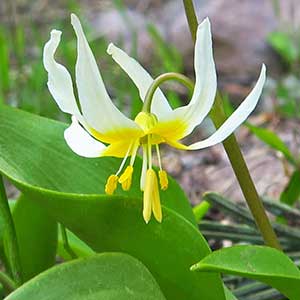Erythronium propullans
Erythronium klamathense
Minnesota dwarf trout-lily, Minnesota fawnlily, Minnesota trout lily
Klamath fawn-lily
ovoid, 10–25 mm;
stolon 1 in flowering plants, arising from halfway up stem, 1–3 from bulbs of 1-leaved, nonflowering plants.
slender, 25–40 mm.
4–13 cm;
blade green, irregularly mottled, elliptic-lanceolate to ovate-lanceolate or elliptic, ± flat, glaucous, margins entire.
6–17 cm;
blade green, lanceolate to narrowly elliptic, ± folded along midvein, margins entire to wavy.
3.9–12 cm.
6–20 cm.
1-flowered.
1–3-flowered.
tepals 4–6, strongly reflexed at anthesis, pale pink to white, darker abaxially, lanceolate, 8–15 mm, auricles absent;
stamens 2–6, 6–8 mm;
filaments white, lanceolate;
anthers yellow;
pollen yellow;
style white, 6–10 mm;
stigma ± unlobed.
tepals 2/3 or more white, with yellow zone at base, ± pinkish in age, broadly lanceolate, 20–35 mm, inner with small auricles at base;
stamens 8–14 mm;
filaments white, slender;
anthers ± yellow;
style white, 4–9 mm;
stigma ± unlobed.
very rarely produced; when present, may be result of hybridization with Erythronium albidum.
narrowly obovoid, 2–5 cm.
= 24.
Erythronium propullans
Erythronium klamathense
Of conservation concern.
Erythronium propullans is known only from Goodhue and Rice counties. It often forms extensive colonies in which flowering plants are sometimes more abundant than nonflowering, 1-leaved ones, and sometimes the reverse. It grows mixed with E. albidum (J. A. Banks 1980), and putative hybrids between them have been reported (T. Morley 1988). Flowers frequently have fewer than six tepals and stamens (C. O. Rosendahl 1919), and may occasionally have only two carpels.
(Discussion copyrighted by Flora of North America; reprinted with permission.)


